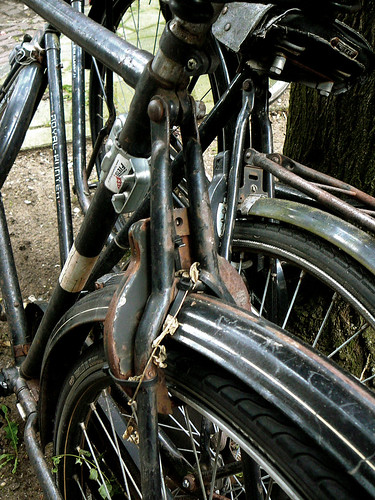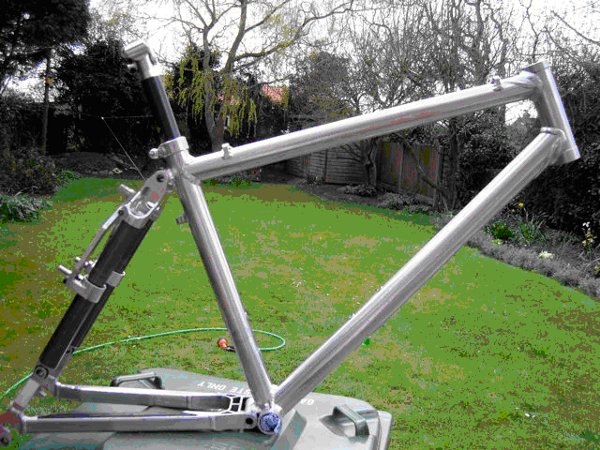Dear Guest,
Please register or login. Content don't create itself!
Thank you
-
 Re: lets set the terminology straight
Re: lets set the terminology straight

Originally Posted by
WadePatton

I've yet to see a rear fork that's all.
Rear forks were the bolt on seat stays used on traditional roadster bikes.

Last edited by Craddock; 03-24-2014 at 06:33 PM.
Reason: Added photo
-
 Re: lets set the terminology straight
Re: lets set the terminology straight
-
 Re: lets set the terminology straight
Re: lets set the terminology straight

Originally Posted by
Craddock

Rear forks were the bolt on seat stays used on traditional roadster bikes.
Don't forget the early Manitou rear suspension.

-
 Re: lets set the terminology straight
Re: lets set the terminology straight
I am a frame builder, but I'm not a framebuilder. It's all in the spacing.

Originally Posted by
e-RICHIE

Let's cut to the chase - what is a framebuilder? Is it someone who can build, or does build, a
frame? Or does one become a framebuilder after reaching a number or experience level atmo?
-
 Re: lets set the terminology straight
Re: lets set the terminology straight
those aren't forks, they are frame components. unbolt the top and it's just pieces parts of a frame. a fork has a crown and a rotational axis.
If one is going to call seat stay assemblies "forks", then why not call chain stay assemblies "forks"?
off topic:
I R a bicycle builder on occasion that the requisite tools, parts, and consumables are in place. I've sucked at making that happen thus far.
-
 Re: lets set the terminology straight
Re: lets set the terminology straight
Shimano called them "rear fork ends" in their dealer parts catalogue, and I could find no argument, particularly when "track drop outs" describes a part wherein the wheel does not drop out when unfastened from the frame. Whose nomenclature is really the foolish one?
Maybe front fork is often overly specific, but perhaps not strictly redundant.
-
 Re: lets set the terminology straight
Re: lets set the terminology straight
Shimano is a Japanese company, i forgive them their language difficulties.
i've seen cable housing referred to as "outer cable" too in the books...wtf is "outer cable"?
-
 Re: lets set the terminology straight
Re: lets set the terminology straight
DT
http://www.mjolnircycles.com/
Some are born to move the world to live their fantasies...
"the fun outweighs the suck, and the suck hasn't killed me yet." -- chasea
"Sometimes, as good as it feels to speak out, silence is the only way to rise above the morass. The high road is generally a quiet route." -- echelon_john
-
 Re: lets set the terminology straight
Re: lets set the terminology straight

Originally Posted by
e-RICHIE

Let's cut to the chase - what is a framebuilder? Is it someone who can build, or does build, a
frame? Or does one become a framebuilder after reaching a number or experience level atmo?
Since the word "pro" in US cycling does not mean you're actually a professional , I can see the same problems with "framebuilder".
I would suggest you're a framebuilder, if you can live a decent life from your framebuilding income.
Didn't they have this all sorted out in the guild system 400 years ago?
-
 Re: lets set the terminology straight
Re: lets set the terminology straight

Originally Posted by
WadePatton

a fork has a crown and a rotational axis.
Rotational axis is necessary for a fork to be useful eating pasta.........
-
 Re: lets set the terminology straight
Re: lets set the terminology straight

Originally Posted by
e-RICHIE

Let's cut to the chase - what is a framebuilder? Is it someone who can build, or does build, a
frame? Or does one become a framebuilder after reaching a number or experience level atmo?
The frame is the frame.
The builder is the builder.
-
 Re: lets set the terminology straight
Re: lets set the terminology straight

Originally Posted by
devlin

The frame is the frame.
The builder is the builder.
The frame is being.
The builder is nothingness.
-
 Re: lets set the terminology straight
Re: lets set the terminology straight

Originally Posted by
WadePatton

I've yet to see a rear fork that's all.
I know there are people out there that object to the fork being called "forks", that's all I was getting at.
-
 Re: lets set the terminology straight
Re: lets set the terminology straight
Ill have a gravel grinder with a spork.
-
 Re: lets set the terminology straight
Re: lets set the terminology straight
A weld or braze fillet is not a soft cut of steak. And they aren't pronounced the same way either.
-
 Re: lets set the terminology straight
Re: lets set the terminology straight

Originally Posted by
Craddock

Rear forks were the bolt on seat stays used on traditional roadster bikes.

The original Travel Bike.
-
 Re: lets set the terminology straight
Re: lets set the terminology straight

Originally Posted by
WadePatton

I've never been one to put a useless zero in front of the decimal point where whole numbers stop and fractions of them begin. point five is point five, or a half unit. never zeropointfive.
I work in a differnet context--I'm an RN--but for us, when dealing with, say, medication dosing, it's *very* important to use those preceding zeros, and never to do a point zero at the end of a whole number.
So for example, one should always write 0.5 mg, lest someone miss the decimal point on .5mg, reading it as simply five milligrams.
For the same reason, one should never write 50.0 mL, as that decimal could be missed and the quantity could be read as five hundred milliliters. In that case, one should simply write 50 mL.
Anyway, obviously a different context, but I would think the same concept would apply--if someone were to have to follow specs you had written, you'd want to eliminate the possibility for end-user error as much as possibility. Speaking in the general "you" here, not Wade specifically.
-
 Re: lets set the terminology straight
Re: lets set the terminology straight

Originally Posted by
C.Dyer

it's *very* important to use those preceding zeros, .
in some forms of engineering trailing zeroes are also defined for upper and lower limit class
a mil really shouldnt be confused with the mil which is used as a unit of angle in calculations for artillery fire unless you of course have a howitzer under the bed
-
 Re: lets set the terminology straight
Re: lets set the terminology straight
whoa. I think this is my favorite thread and I am off to quote e-RICHIE on my facebook status update!
-
 Re: lets set the terminology straight
Re: lets set the terminology straight

Originally Posted by
C.Dyer

I work in a differnet context--I'm an RN--but for us, when dealing with, say, medication dosing, it's *very* important to use those preceding zeros, and never to do a point zero at the end of a whole number.
So for example, one should always write 0.5 mg, lest someone miss the decimal point on .5mg, reading it as simply five milligrams.
For the same reason, one should never write 50.0 mL, as that decimal could be missed and the quantity could be read as five hundred milliliters. In that case, one should simply write 50 mL.
Anyway, obviously a different context, but I would think the same concept would apply--if someone were to have to follow specs you had written, you'd want to eliminate the possibility for end-user error as much as possibility. Speaking in the general "you" here, not Wade specifically.
I agree on the leading zero, but somewhat disagree with the trailing zero. I work in the lab (in a hospital) and all our results have a pre-determined amount of decimal places. A hgb result of 7.0 will always be (7.0), not (7). The clinical significance of the numbers/testing somewhat determines how many decimal places are needed. If you were using larger whole numbers like 50 ml, that would make sense, and it would most likely be standardized that way. Just as long as no one is entering 50.5 or 48.7 somewhere else on your floor. The format should be standardized.
My 2 cents. :)
Similar Threads
-
By AJPM44 in forum Cooks - Epicureans - Toque-istas
Replies: 8
Last Post: 06-26-2014, 04:16 PM
-
By mainemike in forum The OT
Replies: 5
Last Post: 10-15-2013, 10:47 PM
-
By lemonlaug in forum Cooks - Epicureans - Toque-istas
Replies: 20
Last Post: 12-14-2012, 10:18 PM
-
Replies: 6
Last Post: 02-15-2011, 04:52 PM
 Posting Permissions
Posting Permissions
- You may not post new threads
- You may not post replies
- You may not post attachments
- You may not edit your posts
-
Forum Rules
Bookmarks